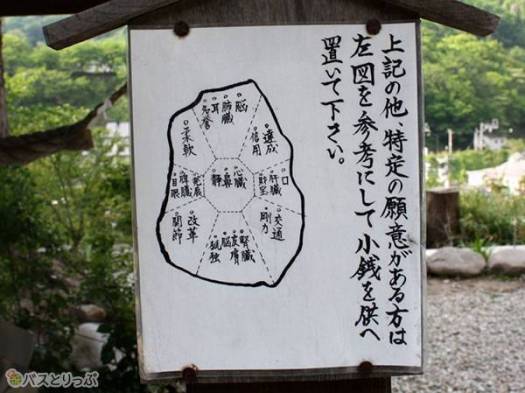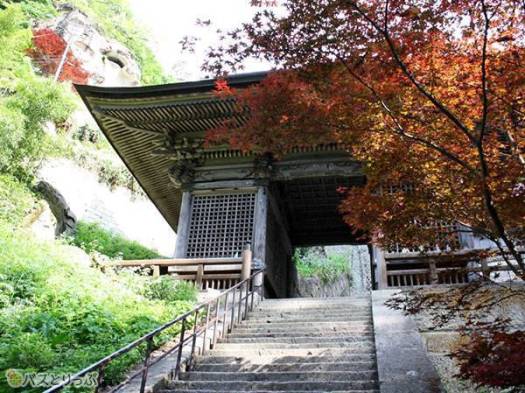Yama-Dera (山寺, lit. meaning « Mountain Temple ») is a Tendai Buddhist temple complex, located in Yamagata prefecture, built on a small mountain. Founded during the 9th century AD at the beginning of the Heian Era, by Buddhist monk Ennin, Yama-Dera offers a 1 000 steps climb, with exceptional scenery throughout the whole ascension allowing for an incredible experience.
« At the top awaits a feeling that you’ll never experience, unless you climb. »
« 登らなければ味わえない感動が、そこにあります。 »
It’s that kind of experience.
Let’s find out more about this temple’s history and what is has to offer!

Of its full and proper name: « Hōjusan Risshaku-ji » (宝珠山立石寺), the temple is commonly known as Yama-Dera. If you wanted to go even further, the fullest name would be « Hōjusan Asokawain Risshaku-ji » (宝珠山阿所川院立石寺), » but I think we’ll stick with Yama-Dera for now.
It is said to have been founded in 860 by a Buddhist monk called Ennin (円仁), who was also known as Jikaku Daishi (慈覚大師, his posthumous name). Although it is certain that the temple was founded during the 9th century AD by Ennin, exact dates and circumstances as to why the temple was founded are still unsure and various opinions and theories exist. Yama-Dera is a branch of the Enryaku-Ji in Kyoto, which is the main Tendai* Buddhist monastery. *Tendai (天台) is a Mahayana Buddhist school established in Japan since 806, learn more: https://en.wikipedia.org/wiki/Tendai
You can access Yama-Dera via a 20 minute train ride from Yamagata station or with a 50 minute train ride from Sendai. I read that it can be a good idea to go Yamagata by night bus if you’re already in the Kantō Area (Eastern part of Japan, including Tokyo). Travel by night and start the day with a visit at Yama-Dera, that can be cool.
Here’s a little map of Yama-Dera that I kinda borrowed from their website : http://www.yamaderakankou.com/origin/
-

Map of Yama-Dera, you’ll probably have to zoom in to read
When you arrive at Yama-Dera, after having climbed the first few steps, the first building you will come across is the Konpon Chūdō (根本中堂), which is the main temple building. Designated as an important cultural asset of the country, it is said to be the oldest Japanese building made out of beech (type of tree), which is rare as a building material. Inside it, is placed a wooden Yakushinyorai (薬師如来) statue representing the Buddha of Medicine, which is said to have been sculpted by Ennin.

What’s interesting is that, in this Konpon Chūdō lies a Buddhist torch called Fugen no Hōtō (不減の法燈), which was originally lit in Enryaku-ji, the main Tendai temple in Kyōto. It was then divided and brought to Yama-Dera, making two of the sort. This lamp, « Bright, Dharma lamp, lighting as far as the Realm Beyond » (「明らけく、後の仏の御世までも、光伝えよ法の灯しび」), was first lit around 1200 years ago, within the prayer of bringing wealth and peace to the world. However, after that, when Enryaku-ji was set on fire and destroyed by Oda Nobunaga (織田信長), it was then the flame from Yama-Dera that was divided and brought back to Enryaku-ji after it was rebuilt, therefore keeping the flame alive.
That flame is still burning today. It’s kind of amazing when you think about it. An old, old flame…
Close, you can find a wish granting rock, called the “Turtle Shell Rock” (亀の甲石) and I think you have to place coins for your wish to come true, but according to a sign next to it, depending on where on the rock you place your coin, the granted wish changes.


So basically, if you’re looking to achieve something, you should definitely place your coin on the upper right corner of the stone. However, if your wish is mouth or liver related, then place it towards the middle-right part of the stone.
I don’t think I totally understand this sign yet.
After walking just a bit, you’ll come across the Temple Gate. And this is where the real fun begins.

From here on out, you’ll be walking (or running who knows) a 800 step ascension to the top, throughout which you’ll be able to enjoy beautiful scenery.


The first building you’ll see on this climb is the Ubadō (姥堂). Inside is located a stone statue of Datsue-Ba. According to Japanese folklore, Datsue-Ba (奪衣婆) is a demon sitting at the edge of the Sanzu River in the Buddhist underworld wearing the face of an old woman, who strips the clothes of those who come across.

From there on, it is considered that below lies Hell and above is the entrance towards the Pure Land (land where Buddha lives). Traditionally, you would clean your mind and body with the water trickling from the rocks and change into brand new clothing. Your old clothes would then be offered to the Datsue-Ba. I don’t think you’re actually supposed to do that when you visit though, that’d be a whole lotta clothes to collect.

It is said that every step you climb cleanses you of your deeds and filth and makes you a more righteous human being.
Then you’ll come across the Niō Gate (仁王門) beyond which is said that people with a wicked heart are prohibited from trespassing. The gate you can admire today is actually quite recent given that it was rebuilt in 1848.

Going from there, plenty of buildings and beautiful surroundings are waiting for you, too many for me to cover, but be assured that this place is full of beautiful sites to check out!
Probably the most famous and praised spots in all Yama-Dera would be Kaisan-Dō (開山堂) and Godai-Dō (五大堂).

First, Kaisan-Dō and to its left, Nōkyō-Dō (納経堂).

Nōkyō-Dō is said to be the oldest building of the whole complex. Standing on a rock peaking out of the mountain, it seems to be overlooking the horizon.

Kaisan-Dō, literally meaning “Temple Founding”, is the temple of Jikaku Daishi (Ennin). There is a wooden statue of Ennin implemented, below which are offered meals and incense in the mornings and evenings.
This view is probably the most famous of all Yama-Dera, with its breathtaking scenery and gorgeous landscapes.
Higher on the mountain is located the Godai-Dō, from which you can probably get the best view of the surrounding Yamagata region. Godai-Dō is a dōjō that was built for worshiping the Five Great Wisdom Kings (五大明王, Godai-Myōō) and praying for Peace upon the World.


So that’s it for this post about Yama-Dera, I hope you found some of it interesting. I really hope I didn’t make any mistakes concerning some of the facts; about 90% of my sources are all in Japanese so if I’ve slipped some, please feel free to correct any that you find!
Have you ever been to Yama-Dera? If so, what were your impressions?
I know I’d love to go!


One Reply to “Yama-Dera 山寺”